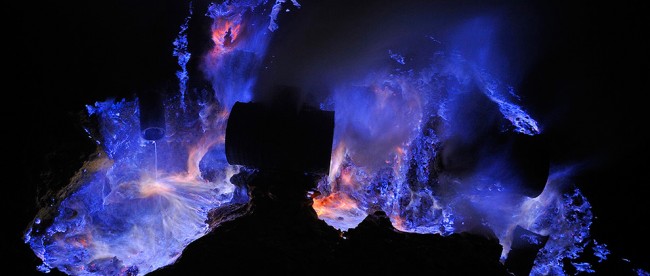The Volcano That Blue Up

Volcanos erupt. And when they do, they often spew ash into the sky as reddish-orange lava flows outward. (You’ve almost certainly seen a photo of one such lava flow, but just in case, here’s a whole bunch of them.) And then there is Kawah Ijen, a volcano in Indonesia. The volcano last erupted in the summer of 1999, so there’s no ash spewing. But there are still lava flows. During the day, the lava looks rather normal. But at night, it often looks like this:

Blue lava!Well, not quite. But close.The picture above was taken by Olivier Grunewald, a French photographer. In 2010, Grunewald made one of the first known trips overnight trips to Kawah Ijen, hoping to get photos of a spectacular accident of nature. The trip was a perilous one, requiring the use of gas masks — Kawah Ijen leaks toxic fumes quite often. In fact, it’s those emissions which cause the visual curiosity above. As National Geographic explained, “gases emerge from cracks in the volcano at high pressure and temperature—up to 1,112°F (600°C). When they come in contact with the air, they ignite, sending flames up to 16 feet (5 meters) high.” Those gases have high amounts of sulfur, and when the sulfuric gases ignite, they give off a blue glow which is invisible during the day, but which can be seen at night against the dark ground and sky.
The ignited gas does not simply dissipate into the air, at least not always. Per Smithsonian magazine, “there’s so much sulfur, Grunewald says, that at times it flows down the rock face as it burns, making it seem as though blue lava is spilling down the mountainside,” leading to the spectacular effect seen above.
The large amount of sulfur has another effect on the area — one beyond incredible aesthetics. Miners, per the Boston Globe, trek to the volcano to collect the mineral after it has cooled and then sell it to local nearby industries. In doing so, they can earn about $1 per 100 pounds collected. In a typical day, this can mean about $5 a day in earnings, which is roughly equal to the typical per capita earnings for the area.
More of Grunewald’s photos of Kawah Ijen can be seen here, and his short (2:19) documentary of the photo expedition can be watched on YouTube, here.
Bonus Fact: In many movies — for example, the Lord of the Rings — people (or whatever Gollum is) fall into lava and quickly sink as they burn into oblivion. In reality, that wouldn’t be the case. Lava is much, much denser than water and, for that matter, much more dense than you or I am. As Wired points out, anyone who fell into lava would likely stay afloat — but ultimately succumb to the thousand-degree heat anyway.
From the Archives: Volcanic Scream: How a volcanic eruption likely influenced a famous work of art.
Take the Quiz!: Name the countries that are home to the volcanoes listed.
Related: “Volcanoes!” A Nat Geo for Kids book. Amazon’s top seller in the “Children’s Earthquake & Volcano Books” category, which seems like a pretty specific and therefore small category, but actually has a huge number of books to choose from.
